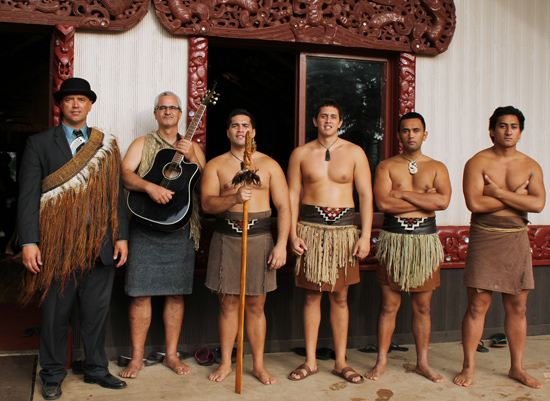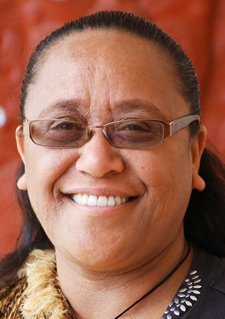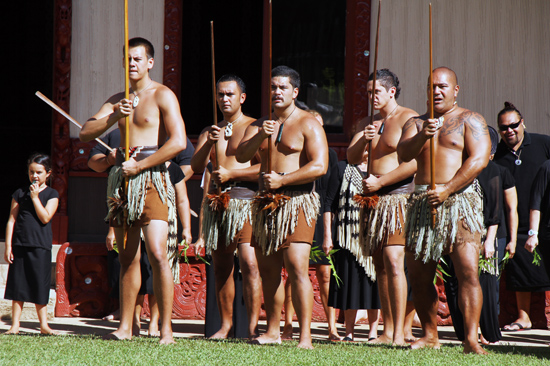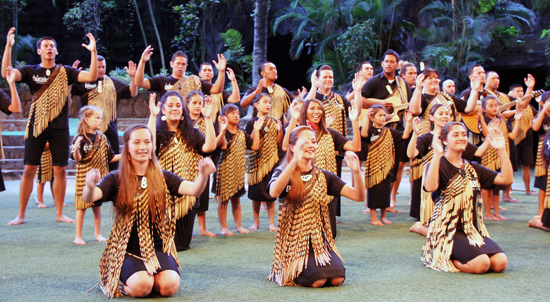Māoritanga — Māori culture — is very much alive
Occasionally, a travel writer may describe the Polynesian Cultural Center as a “living museum”: That is, a place where we’ve recreated the past, but that’s not really accurate. Granted, most Polynesians now-a-days live in modern housing and dress in current fashions, whereas all of our PCC village houses are traditional and many of our villagers wear more traditional clothing; but even in this regard, most of our village staff dress traditionally. In the Samoan or Fijian villages, for example, will see traditional structures and lots of people wearing lavalava or wrap-around sarongs in every-day situations.
Yes, some of our PCC structures represent a former Polynesian way of life. For example, there are very few Hawaiian hale or houses any more, even in Hawaii, and of those, there are almost none in which people live; but several of our other villages would be “right at home,” so to speak, back in their own islands.

Men of the Polynesian Cultural Center Māori Village
Nowhere is this truer than our own Aotearoa Village, which faithfully represents the modern Māori people of New Zealand as well as their ancestors. Visitors to that beautiful South Pacific country will find people speaking Māori, watching Māori-language media telecasting country-wide kapa haka or traditional Māori song and dance competitions, and utilizing one of almost a thousand Māori marae — compounds with carved meeting houses and related buildings that people use frequently for welcoming visitors, weddings, meetings, seminars, wakes, funerals, and more.

Seamus Fitzgerald, Islands Director
PCC Islands Director Seamus Fitzgerald, a Māori from Turangi, North Island, New Zealand, said every extended family has its own marae.
His small home town with its population of about 3,000 people has seven marae, “and in neighboring Taupo there are another five.”
“In Ruatoki, another place where we both come from, there are nine on one road,” said Rahira Makekau, PCC’s Māori Cultural Performance Specialist. “Everyone affiliates with a minimum of two. Of course, with intermarriage we actually affiliate with many marae.”
Fitzgerald said among the student workers in the Aotearoa Village today there’s are many for who this is their first experience with Māori culture, while for others “because they’ve been raised around a marae, they already know what they’re doing. We only need to train them for a week or two in our own procedures.”
Following the tradition of honoring their ancestors by naming their marae’s after them, the Cultural Center’s Māori village marae is named Te Arohanui o Te Iwi Māori Marae, which means “The Great Love of the Māori People”) as a tribute to the sacrifices of the labour missionaries who came here to build the PCC in 1963. These workers also made up the first Māori performing group here at PCC and are known as Te Arohanui Māori Company.

Rahira Makekau Maori Cultural Performance Specialist
“One of the special things about the Cultural Center marae is that we are able to share with those students who are learning their culture, guide them, and give them experiences they would have normally had if they were home,” Makekau added. “That’s not to say that Māori have to be raised around a marae, but they are very much alive back home.
For example, it is at our funerals, our tangi, that all of the aspects of our cultural protocols and practices that make us Māori come together. That is all very much a part of us.
“During many of the events on a marae back home, the mattresses come out and members of the extended family sleep over. That’s why these meeting houses are as big as they are. We always have an ablution block, showers and bathroom facilities; and of course, a huge dining room. Those are the three buildings that predominantly make up a marae setting.”
Fitzgerald pointed out that food doesn’t fit into the traditional nature of a meeting house: “The realm that exists inside a whare nui is typically seen as sacred or tapu. We try not to bring in things that are noa” [different/not sacred]. “Having a whare kai back home keeps things in a separate place,” he continued. “Because we’re part of the Cultural Center, we always look at the Gateway Restaurant as our whare kai, which helps us keep all the parts of our protocol in order, because we know our guests are going to eat at the luau or the buffet — all part of our extended marae.”
In addition to the beautifully carved structures, performing kapa haka —traditional Māori songs and dances — is another aspect of Māoritanga that is very much alive, both at the PCC and in New Zealand.

Welcome at the Polynesian Cultural Center Māori Village
Mākekeu, for example, recalled how her grandmother “was a strong composer and well-known tutor in her time. She taught haka, which not a lot of women do even now. She taught men to wero [challenge arriving guests]. She composed a lot of songs that are well-known around Ōpōtiki, and some have even spread into the nation, and she taught us as a family. I got the gene, I think, because from the time I could walk and talk we were all doing poi. I was very fortunate when I was old enough to go to Auckland and join Te Waka Huia [an award-winning group] as a foundation member.” In fact, Makekau explained that this month Te Waka Huia defended their title in the Mātātini Festival, which was held this year in Christchurch, South Island, New Zealand; and Fitzgerald described the festival as a “big celebration of our culture,” attracting 40 top groups, crowds up to 40,000 and national telecasts for three days.
“It’s one of the most positive things to be at,” he said. “Our people are too often portrayed in the media in negative ways; but when you see them celebrating the songs and dances, it’s all about what our people are, were and will be.” “Mātātini is the national Māori performing arts competition. The best groups have all survived regional competitions over the past two years.
The best groups come together to perform for the championship and Te Waka Huia has always been in the top three,” Makekau proudly added. “It takes up a major part of the lives of the people who are involved with it, but it’s thrilling. Ask a Hawaiian what it’s like to stand on the Merrie Monarch stage in Hilo, and it’s the same feeling at the Mātātini.
Fitzgerald started a similar series of competitions at the PCC, “simply knowing that we have so many Māori who live here, even second and third-generation who were born and raised here. We wanted them to learn our performing arts and our culture away from the night show stage, which is more tailored to be educational and entertaining for guests who are generally unfamiliar with the culture.”

Māori locals performing at the Polynesian Cultural Center
“We tailor our competitions here to be a strong representation of our culture,” he continued. “We started here with the hope that one day we would be able to take a team from Hawaii — not necessarily the PCC — to participate in the Mātātini, because they accept groups from Australia; and we have had an open invitation to go to the regional competition in Australia for the last four years. That invitation opens the door.”
“As a result of having our festivals here,” Makekau said, “all our people from home — and we’re talking about some of the top groups in the country, have been here at the Center. For them to perform on our little stage in the Māori Village whare nui is really humbling. It’s a beautiful thing. We’re constantly having groups who want to come and perform here. What an awesome opportunity it is to share PCC with all of them.”
“I think the highest compliment we can give is that when visiting Māori come here, they feel at home,” she said. “Māori who have been involved in kapa haka and involved in their marae at home, they’re major advocates of language and all of our performing arts. They come here and don’t want to leave. It lets us know we’re doing something right.”
“We’re so grateful that we’re able to perpetuate it here at the Polynesian Cultural Center, and what an awesome opportunity we have to share it with not only our students, but also our guests. I always feel that the Polynesian Cultural Center’s original mission to preserve and portray the cultural arts and crafts is still very valuable today,” Fitzgerald said. “This is still a place where you can come and see how Māori live today, and how Māori have lived for years, and will continue to live. Our culture is one our people don’t want to lose.”
Story and pictures by Mike Foley

Mike Foley, who has worked off-and-on
at the Polynesian Cultural Center since
1968, has been a full-time freelance
writer and digital media specialist since
2002, and had a long career in marketing
communications and PR before that. He
learned to speak fluent Samoan as a
Mormon missionary before moving to Laie
in 1967 — still does, and he has traveled
extensively over the years throughout
Polynesia and other Pacific islands. Foley
is mostly retired now, but continues to
contribute to various PCC and other media.

Recent Comments